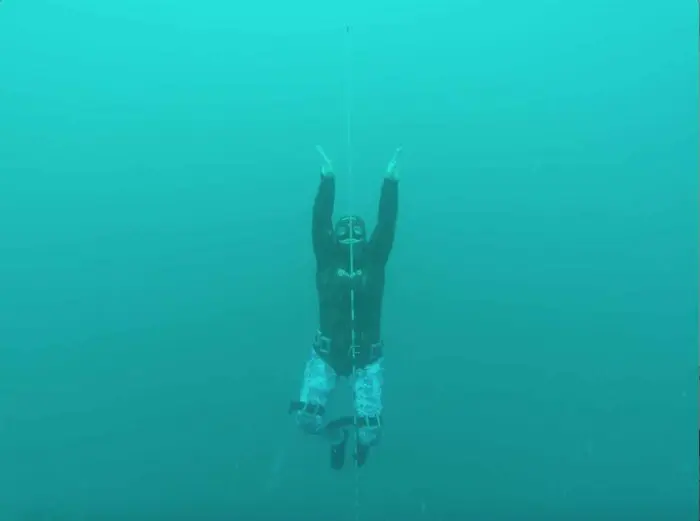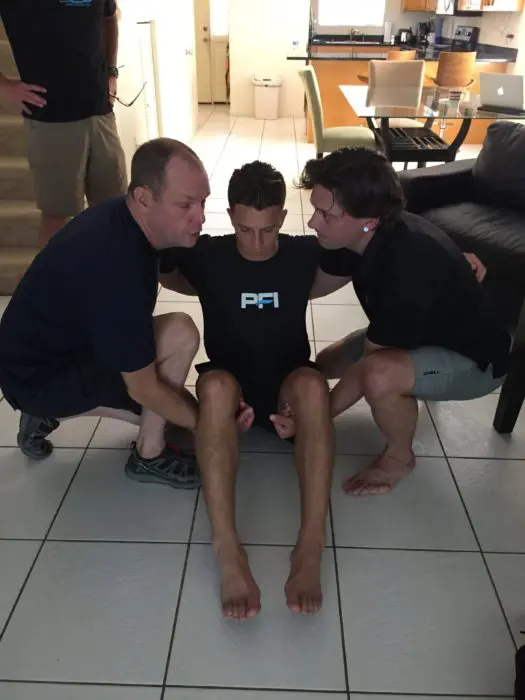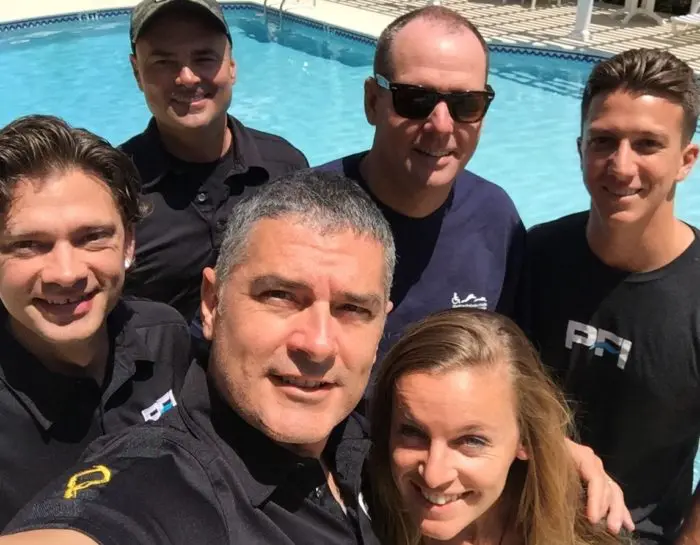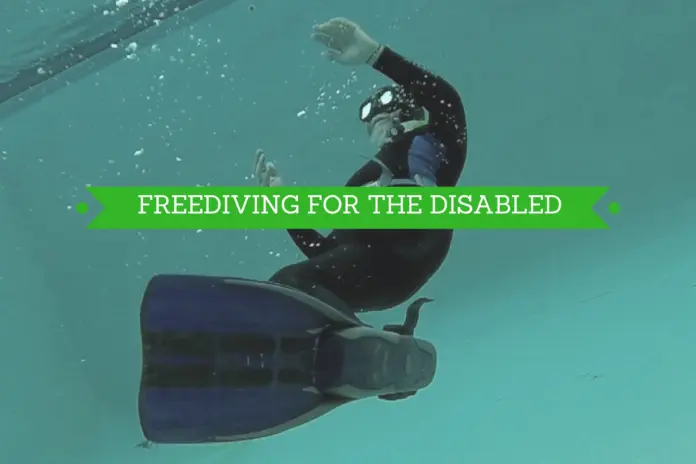Kirk Krack has been freediving since his childhood, ‘snorkeling’ off the family sailboat. He was a lifeguard and swimming instructor as a teenager and became a scuba instructor at the age of 20, in 1988. Two years later, he bought his first dive shop and progressed through the various stages of recreational and technical dive qualifications. Although freediving started as more of a hobby than a serious persuit, by 1999 it had become his primary focus. He coached well known athletes such as Tanya Streeter and Brett LeMaster and founded Performance Freediving International (PFI) in January 2000.
Whilst PFI have been working with disabled divers for years, they launched their Adaptive Freediver program at Blue Wild earlier in 2016.
DeeperBlue.com caught us with Kirk to find out about the program he offers to people with disabilities.
DeeperBlue.com: What inspired you to write a program for disabled freedivers and how long have you been developing it?
Kirk Krack: My work with people with disabilities started as a lifeguard in the early 80’s and then progressed with me becoming a scuba instructor in 1988. In 1989 while working in the Cayman Islands as a dive instructor and boat captain, I was approached by a customer, an 88 year-old lady, whose name I’ll never forget – Geraldine Turner. She was using a walker and her brother was carrying her equipment as she approached me while I was prepping the boat for an afternoon two-tank excursion. She asked me if I was the captain on her trip and then began to tell me how we were going to work together, due to her strength and mobility issues. To her surprise I said ‘No problem, how can I help you?’ and together we enjoyed a one-on-one dive on the local reef while I was basically her DPV. That was very rewarding to be able to help another person enjoy our underwater world. In 1990, I had a wonderful wheelchair bound scuba customer that also really inspired me. She showed me with an incredible enthusiasm that all people on some level can enjoy our oceans.
During this time I also trained a hearing impaired diver through to divemaster while also learning limited American Sign Language myself. Since 2000, PFI has had many customers with varying disabilities, mostly amputees and a hearing impaired persons that we worked with and did our best to help them to adapt. One gentleman in particular, Kelly Smith, also inspired me to work more with people with disabilities and to develop a specific program. Kelly was a Paralympian athlete from Canada, competing mainly in category T54 long distance wheelchair events in which he won a silver medal in Athens. He took an Intermediate Freediver course with us in Kona, Hawaii and he achieved 30m/100ft using a monofin, binding his legs and using all upper body. The next year he joined us at our Deja Blue competition where he did 45m free immersion and also set the Canadian static apnea National Record of 7:24 which still stands today, along with also competing in our F3F scooter races that year.
However my realization of creating an adaptive freediver program came from a student I met who would eventually become a good friend and colleague, Hubert Chrétien. Hubert is a passionate scuba instructor who specializes in working with people with disabilities through his non-profit organization Freedom At Depth. He has been teaching in that capacity since 1993 and is one of only two Handicapped Scuba Associations (HSA) instructor trainers in the world. Hubert was a successful business person who decided to give it all up to dedicate himself to teaching people with disabilities and in December 2015 he was recognized with one of Canada’s highest civilian honors , the Meritorious Service Medal, for his inspiring work. Hubert eventually went through PFI’s Instructor Program with the hopes of helping his disabled clients and together we decided to develop a program for PFI based on the philosophies and structures of the HSA.
In the summer of 2014 Hubert trained trained me as an HSA Instructor and then immediately after we taught an Intermediate Freediver course together to five of his scuba clients. We have since taught three different Intermediate Freediver level programs to his customers with disabilities ranging from amputees, to polio affected limbs to a woman that was parapalegic. This past May, after a six month development of our system headed up by Hubert, myself and Chris Bustad one of our lead staff instructors, we ran our first PFI Adaptive Freediver Instructor program for five of our PFI Instructors. In fact, at the writing of this we are running our first full program within the PFI Adapative Freediver standards and procedures in Miami with Chris and Hubert.

DB: Is there a minimum set of requirements that Adaptive students have to fulfill before they qualify? Does it differ depending on their disability?
KK: A person with disabilities is like any other person with a passion to learn new skills, however there may be additional medical approvals required depending on the particular disability or medical condition. Also the level and type of disability may dictate the direction, learning strategies, tempo and student ratios. Disabilities aren’t always apparent; they can be physical or cognitive or learning disabilities, and our instructors are trained to assess this and adjust their instruction style accordingly. For example, teaching a below the elbow amputee is relatively similar to training an able bodied person, and the training process and student to instructor ratios need not be adjusted.
Working with a low-level parapalegic person, however, requires more time, skill development, technique adaptations and adjustment of the student to instructor ratio to one-on-one. Similarly, a person with a learning ability may require a more individualized approach to instruction.

DB: Give some examples of adaptation. For example, weight distribution and the buddy system are different for disabled scuba divers.
KK: What’s important to understand is that the basic philosophy of the system is predicated on the idea that there is a potential, but not always inevitable, requirement to adapt the training standards for a person with a disability. Just because you have a disability doesn’t necessarily mean you have to take an Adapative Freediver program. If a person’s disability doesn’t affect their ability to learn and participate with able bodied people, and if they are able to complete all the training and safety objectives, then despite the disability, there is no need for an adaptation.
However, when a person’s disability may affect their ability to learn within a standard class, or if they are unable to complete specific training standards (for instance can’t complete a constant weight dive with fins to 25m/82ft because of paraplegia) or if they can’t effectively and properly provide safety to their dive buddy or themselves, then they need to work within an Adapative Freediver program where the standards have been carefully thought out to provide education while still maintaining safety particular to the needs of that individual.
For example, a person who has no use of their legs (paraplegia) is unable to perform the finning to depth and back and must rely on free immersion (pulling to depth and back with one’s arms), but they must also be able to independently get back to the surface on their own in a safety situation. Or if a person can perform all necessary diving skills, but cannot adequately provide in-water rescue breathing to a blacked out diver, then recognition of that important safety fact must be made, and they may qualify for a different level of certification. This is where the original HSA system of mult-level certification became important to PFI and why we adopted their system by certifying freedivers as either an Adaptive A or Adaptive B freediver’, which distinguishes between the various degrees of ability to comply with standards.
• Adaptive A: the student has successfully challenged all of the PFI Adaptive Freediver Physical Performance Standards, demonstrating that he or she can safely freedive, solve basic personal emergencies, help another freediver in distress, and perform basic rescues. They have shown, by successfully challenging these standards, that they can perform the skills required to be an effective buddy and are certified to dive with one other certified freediver.
• Adaptive B: the student has successfully challenged those PFI Adaptive Freediver Physical Performance Standards that demonstrate their ability to safely freedive, and to solve basic emergencies. However, they are unable to successfully challenge those Performance Standards that demonstrate their ability to help another diver in distress. Therefore, the Level B Freediver is certified to freedive with TWO BUDDIES that are certified Level A or above. In case of emergency, this system will provide an effective dive buddy for all members of the dive team.
An example of what this all can look like is that of a woman who was paraplegic and taking an Intermediate Freediver program at a quarry in Ottawa. She was very buoyant and couldn’t control her legs and body position during ascent/descent. So we distributed weight on her neck, waist, knees and ankles, which improved her trim so she would be balanced. But head-down descents weren’t going to work for her either, so we created a lanyard around her ankle that would secure her to the line. So effectively she would breathe-up head up, sitting on a noodle with her ankles attached to the line and would then pull herself down the line free immersion-style in a heads up position. Once at depth, she could swim unassisted to the surface and if an emergency arose, she could also ditch her waist weight belt where more than 50% of her weight was located to achieve better buoyancy. So in a cold quarry in Ottawa, wearing 6.5mm wetsuit, this determined woman got to 22 meters where she spent 15 seconds looking at a sunken mini-sub she’d seen on scuba and then self-propelled back to the surface. In addition, because of her inability to control her legs she had a couple skills when rescuing another diver that wouldn’t be effective or safe and therefore she was certified as PFI Adaptive Freediver B.
DB: What is the most common disability you come across in your students?
KK: By far amputations. However within the able bodied community we find it is most often ego!
DB: Do you teach many veterans? Can they get grants to attend your program?
KK: We’ve taught a number of veterans and there would be grants available depending on the country and the organization offering the grant. We are currently working toward setting up veteran-specific programs and this is one of Chris Bustad’s passions and his focus with the program as we move forward.
DB: How does your program affect your students (physically and mentally)?
KK: It’s empowering for them. It instills confidence, just as it does with able bodied students, and for those that will primarily be scuba divers, it provides a whole new level of ability and self safety. We also have several people with amputations who have given up scuba and have become avid scooter freedivers, because it gives them a whole new sense of freedom and power. Where their disability would have limited their movement and propulsion, they can now zip around with freedom and still have all the self safety skills needed to get to the surface should the scooter fail.
DB: How and where can a freediving instructor take a course to help them teach disabled freedivers?
KK: We’re working on our schedule for the 2017 year to offer a number of programs, but you also have to realize that our Adaptive Freediver Instructor program is developed in conjunction with our regular programs, philosophies, strategies and techniques, and therefore as a pre-requisite one must be an active status PFI instructor.

L>R back row: Chris Bustad, John Hullverson, Hubert Chrétien, Andrew Miramotnes
L>R front row: Kirk Krack and Shell Eisenberg
DB: Is the course taught outside the USA?
KK: We’ve taught this program primarily in the USA and Canada and will be offering more programs for both interested freedivers and PFI instructors globally in the future.
DB: What’s the most rewarding part of your job?
KK: We started on the road to developing the PFI Adaptive Freediver program not because we saw a market potential and a revenue source. In fact, when you look at the student to instructor ratios, the additional time required for a program, and many other variables, you can see where the business side of it falls off very quickly. I feel very fortunate with my career path, my success within it and the amazing people that I’ve met along the way, and I feel like this is a way of showing that gratitude and sharing my love of the ocean with others, particularly those who might not have that opportunity without our program.
I’ve always had the philosophy and true belief that everyone, at some level of participation, should be able to enjoy our underwater world, and I’m thrilled to be able to help in that regard.
DB: What’s the hardest part about teaching disabled divers?
KK: Time management. Getting to the pool or ocean, getting suited up, getting the diver into the water, with assistance if necessary- all of that can be difficult, so in an Adaptive Freediver program acute attention to time management must be a priority from a logistical point of view.
DB: Can you share your favorite inspirational story?
KK: There are actually two that I’ve already mentioned above. That of Geraldine Turner, the 88 year-old woman who first opened my eyes to the true abilities of the “dis-abled”. At her age and with all the limitations she experience physically from a strength point of view, she just so loved the underwater world that she wasn’t going to let her limitation stop her and she wasn’t scared or embarrassed to ask for the help. All she needed was someone who shared her passion and was willing to share the journey.
Also that of Kelly Smith. After a tragic climbing accident left him in a wheelchair, he went on to become an amazing athlete and motivational speaker and when asked about it says he wouldn’t change a thing. Kelly refused to let his disability define him or hold him back and he went on to excel in so many endeavours including freediving.
You can find out more about the PFI Adaptive Freediver program at www.performancefreediving.com

